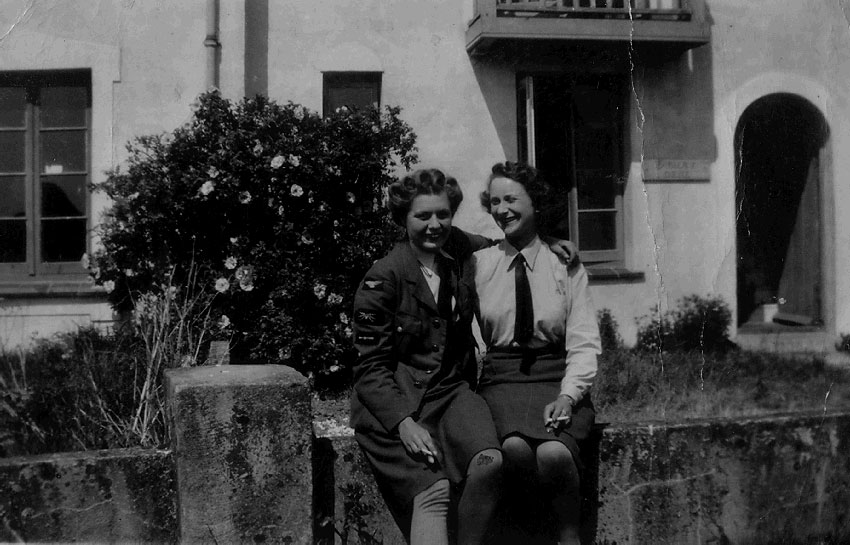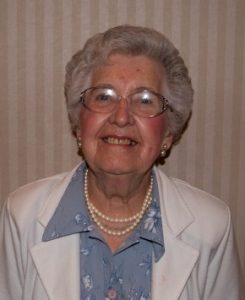Women’s Auxiliary Air Force in Radar
The Women’s Auxiliary Air Force, (WAAF) was an all female division of the Royal Air Force. It was established in Britain at the outbreak of war in 1939. Women were provided with basic training and were put to work monitoring radar stations, telegraphs, telephone communications and more. Canadian women also joined in these operations. In Canada the group was called the Canadian Women’s Auxiliary Air Force (CWAAF), and they performed the same tasks as their British counterparts. Some even served overseas. By the end of the war, over 15,000 women had joined the CWAAF.
Janet Adelaide (Taylor) Bates
Jan Bates served as part of the Women’s Auxiliary Air Force in World War II, and like other radar personnel, was under the Official Secrets Act until 1991. During her service in the war, she met fellow radar service person, George Fredrick Bates. They married after the War and eventually became involved with the Secrets of Radar Museum. She passed away in 2012.
[Letter based on oral history interviews]
Dearest Mother and Father,
I am truly sorry it has taken me so very long to write to you. The Royal Air Force has kept us ever so busy with training. There is little time set aside for such luxuries.
I cannot speak in much detail about my work as a Clerk Special Duties; suffice it to say, the job we WAAFs do may turn the tide of this awful war. I’m glad I took uncle’s advice and signed up for the most well-paying position. The work is hard, and a bit lonely, but worthwhile.
Listen to Jan’s account with a transcript
The conditions here are so very isolating. I tire of the 6-week courses here and there. Every course is on a new and different machine. I suppose that is the price one pays for being good at one’s job. The latest one is nicknamed OBOE. I’m sure the censors have blacked out much of this, but it helps me to write it down.
There has been one bright spot in all of this. At my latest posting, at Hawkshill 6, I made the acquaintance of a young and charming Canadian. His name is Frederick Bates, a Radio Mechanic in the RCAF. We ride together to work each morning; my friend has taken to switching seats with him so that we might chat more. I will let you know if this relationship blossoms into something more. Dare I say it, I may even marry this man.
I do miss my time growing up in Spain. It was so very much warmer than my boarding school days in Edinburgh. However, had I not been there at the beginning of the war, I’d never have had this amazing opportunity. Besides, it was either sign up with the Air Force when I did, or be conscripted later. I feel that I made the correct decision.
Your loving daughter,
Jan
**addendum – November 10, 1992 – I did in fact marry Fred Bates, he was too good to let go. We moved to Canada, and settled in Dundas, Ontario after the war. I never sent this letter (a few too many secrets), but kept it as a memento of my time working in radar. It’s good to be able to talk about it now.
Edna Mae (Burrows) Simpson
Edna, also known as Bunny, served as a member of the WAAF in Britain. During her service working with radar, she met her husband Douglas Simpson, and moved to Canada as a war bride. She was interviewed by the Living Memories Project where she told her story. Edna passed away in 2014 in her 92nd year.
[Adapted from oral history interview.]
A Letter
Dear Mum,
I was so glad when I got your last letter. The plan is to stay at Lizard Point a little while longer. The war’s done but there’s still so much work to be done here.
It’s amazing how far I’ve come, how far we’ve all come really, since I was sent off bushy-tailed and bright-eyed to Walton-on-the-Naze. I don’t think any of us girls really knew what was going on. It was a trial by fire for the lot of us.
The up side of it was that I didn’t have to worry about the censors. I couldn’t tell anyone what I was doing because I didn’t know what I was doing myself! Not to worry though, when the RAF had spots open at the radio school, we got more than enough training.
The southern countryside is nothing like home. It took some getting used to, but at least I never left the sea. For all my complaining that I couldn’t join the Navy WRENs my time as a WAAF means so much to me. Except for that time in Wales – the scran was awful. But even lousy food and bunking in those Nissen huts beat being in the army.
Lizard Point is lovely. It’s all field until you get to the shore, which is as rocky as can be. Much warmer water than back home. If there’s one good thing about the south, it’s that.
If you are up for it, I was thinking of bringing Doug Simpson up for another visit next month when we both have leave. You’ll remember him, he’s that young Canadian radio mechanic I brought home last time. He’s been going on about meeting some of the folks from the Health Ministry. We stayed in touch as much as we could with the war. With the different postings and all, losing touch can’t be helped sometimes.
Do let me know as soon as you can, I want to get the plans finalised soon. I don’t want the worry of a last minute trip like last time. You know how that went.
Yours truly,
Bunny
PS. Send my love to the rest of the family.
Courtesy of Edna Simpson and Jan Bates



